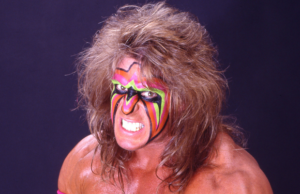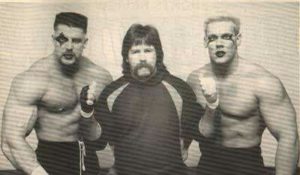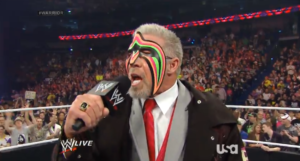
“Every man’s heart one day beats its final beat. His lungs breathe their final breath and if what that man did in his life makes the blood pulse through the body of others and makes them believe deeper in something larger than life, then his essence, his spirit will be immortalized by the storytellers, by the loyalty, by the memory, by those who honor him and make the running the man did live forever.”

The Ultimate Warrior ascended into Parts Unknown literally eight hours after I had already turned in this issue’s column, but surely this event was worth stopping the presses for. While he is far from being one of my all-time favorite wrestlers, do not expect a hatchet job on Jim Hellwig the person. Surely, my “smart fan” observations on Hellwig’s locker room conduct and his personal politics have little to no place in this magazine. Instead, let us remember the in-ring persona that was quite exciting to watch in the WWF ring during the late ‘80s and early ‘90s.

Warrior was first brought to my attention via the wrestling magazines back in 1986 when he was known simply as “Rock,” a member of the Blade Runners tag team in the UWF. The Blade Runners—Rock’s partner was “Sting,” who wrestling fans may have heard of—were nothing more than a Road Warriors knockoff, but you have to start somewhere. During this time, I don’t think anyone would have guessed that either of these two musclebound goons would go to ANY height in professional wrestling, much less what they managed to achieve in their respective singles careers. After the tag team split up, Blade Runner Rock moved on to Texas and World Class Championship Wrestling, changing his name to the Dingo Warrior. As a member of the World Class roster, the Dingo Warrior enjoyed a tag team title reign alongside Lance Von Erich and won the Texas Heavyweight Championship in a tournament final that took place in January of 1987. Supposedly, New Japan was interested in having him portray their “Big Van Vader” character, but the Dingo Warrior instead signed with the WWF later that year. After a few months on the house show circuit, Warrior made his WWF television debut on the October 25th broadcast of Wrestling Challenge, running over perennial jobber Terry Gibbs like a freight train. With his debut came another moniker change. Wrestling already had the Road Warriors wrestling for the NWA, as well as Kerry Von Erich referring to himself as the Modern Day Warrior in World Class. The WWF’s warrior needed to stand tall and proud above the rest—he needed to be ULTIMATE. The Ultimate Warrior was born.
Warrior dove into his Ultimate role with gusto, capturing the imaginations of kids all across America. Most wrestlers walked to the ring; the Ultimate Warrior took off out of the locker room at a full sprint. When his entrance music hit the PA speakers, you knew that some poor sap like Gibbs or Steve Lombardi was about to get his ass handed to him quickly and effectively. Herein lays another bone of contention I have with the workrate fanatics and their at-times-unrealistic expectations of more character-driven wrestlers. While I understand that the brief duration of his matches was usually by design due to his lack of cardio training, I gotta wonder how you can possibly expect matches featuring a guy named the ULTIMATE WARRIOR to last longer than thirty seconds against a much lesser foe.
His push to the main event began when he snapped Hercules Hernandez’ chain during a tug-of-war that led to their collision at WrestleMania IV in 1988. When the Honky Tonk Man found himself without a challenger to his Intercontinental championship at the inaugural Summerslam later that year, out came the Ultimate Warrior much to everyone’s surprise. You knew exactly what was going to happen—Honky’s fourteen-month tenure as champ was going to end in about as many seconds! I actually had the privilege of witnessing one of their return bouts live at the Oakland Coliseum. Fortunately, it lasted a bit longer than their match at Summerslam. The Ultimate Warrior’s Intercontinental title reign led him to another deceased wrestling legend, Ravishing Rick Rude, who took the belt from him at WrestleMania V with a little bit of help from manager Bobby “The Brain” Heenan. Fortunately, all of the little Warriors saw their new hero come back at Summerslam ’89 to wrest his championship back from the Ravishing One’s grasp. From there, the Warrior embarked on a war against the Heenan Family, beating Andre the Giant at house shows in mere seconds. Mind you, the Giant had taken Hulk Hogan to the limit at WrestleMania III two years earlier, so seeing him dispatched so quickly and easily was a HUGE deal to many of us younger wrestling fans.

Speaking of the Hulkster, his time would come as well. After a few in-ring confrontations between the two, the stage was set for the Ultimate Challenge—the Warrior was actually going to step into the squared circle with his Intercontinental championship and challenge Hulk Hogan for the world title at WrestleMania VI. An epic clash that defied expectations took place, dividing the audience’s loyalties as many of us were not used to “good guys” wrestling against one another. The Ultimate Warrior more than held up his end of the match and came out on top, standing tall with both championship belts in hand. Of course, the Intercontinental title was later vacated, but that is beside the point. The stage was set for the Ultimate Warrior to carry the WWF banner into the 1990s…or was it?
Although we as fans had every reason to believe that Warrior was Hulk Hogan’s successor, there were similarities between his time at the top and “Macho Man” Randy Savage’s year-long reign between 1988 and 1989. Both were overshadowed by Hogan’s six-year run of dominance that saw him turn back every challenge, so who was supposed to pose a believable challenge to the Ultimate Warrior? Ted DiBiase, Mr. Perfect, and Haku were all handily defeated, as was Warrior’s old nemesis Rick Rude in a cage match at Summerslam ’90. With no real challenges on the horizon, the Ultimate Warrior’s drawing power began to slip as the fans began to turn on him, not accepting him as the WWF’s new top dog after all. The 1991 Royal Rumble saw the Ultimate Warrior lose his championship via Randy Savage’s outside interference to a returning Sgt. Slaughter, who had renounced his patriotic past to become an Iraqi sympathizer during the first Gulf War. Rather than attempt to regain his title, the Ultimate Warrior set his sights on the Macho Man. The stage was set for WrestleMania VII, in which the two titans would collide with their respective careers on the line. The Ultimate Warrior emerged victorious in a fantastic battle that was even better than his championship match against Hogan the year before, sending Savage into retirement. Savage came out of retirement shortly after, but that is another story for another time.
WrestleMania VII was really the conclusion of the Ultimate Warrior story, as his career went downhill during the rest of 1991. A rivalry with Jake “The Snake” Roberts had promise, but the build-up vignettes were a little too dark and weird for my tastes as a fan. Matches between the two never took place, as the Warrior became embroiled in a financial dispute with Vince McMahon that saw the WWF owner temporarily accept his wrestler’s demands before benching Warrior for the next eight months. His next appearance would be at the end of WrestleMania VIII, in which he saved Hulk Hogan from a post-match attack by the likes of Sid Justice and Papa Shango. Although the audience was happy to see him back, their enthusiasm was short-lived thanks to a goofy rivalry with Shango that nobody particularly enjoyed watching. After failing one too many steroid tests during 1992, the Ultimate Warrior was fired or quit, depending on whom you talk to. The legend faded into obscurity for the next several years before a brief return to the WWF fold, as well as an embarrassing three-match run with WCW in 1998 where Warrior and Hogan attempted to recreate their 1990 magic that resulted in one of the worst matches of all-time. The Ultimate Warrior’s wrestling career was definitely over.

The Ultimate Warrior died several days after being inducted into the WWE Hall of Fame by Linda McMahon and not even twenty-four hours after an appearance on Monday Night Raw. His remarks on Raw seemed to foreshadow his own death, serving as a eulogy to his career and the way he tried to live his life. Beneath his often-incomprehensible promos was the positive message that although our world is often harsh and fucked up, we each can strive to be better people and to never lose sight of the values and ideals that makes you who you are. Not a bad way to live if you ask me.

